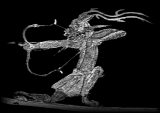
The Moshcheveya Balka Bow
By Andrew Hall
Below is a photograph of my fifth composite bow. It is based on one of the circa 8th century bows found at the Moshcheveya Balka site in the northern Caucasus, Russia, (the bow kept in the St. Petersburg Hermitage). It is fairly close in dimensions and angles to the original, although the limbs are thinner.
The bow is about 49 inches between
the inner nocks and about 1.5 inches wide mid-limb. It has an ash core, cherry
siyahs with "bone" plates made from holly. (The original has a core made from a
single piece of cornel wood).
With the difficulty I had with the
initial bending of limbs and stringing I was expected the bow to be quite heavy.
But with the leverage of the long siyahs the draw weight came out at a
lightweight 37lb at 27 inches. I am intending to put another layer of sinew on
the back. As well as increasing the draw weight, it will enable me to stiffen up
the inner limbs a bit.



It is not that visible in the photo, but the bow has a slight
hinge on a narrow section of the inner limb next to the grip on the left limb in
the photo. It is not obvious as it tends to cancel out the increased grip/limb
reflex on that limb (the original was slightly asymmetric in grip/limb angles).
I hope to be able to stiffen this section with more sinew as it worries me.
Most of the documented arrows were
painted red, some with a blue/green band. Mostly birch, heavily barrelled and
quite stiff.
As long as I do not introduce any twist in stringing, I have not noticed the siyahs leaning over. I have left it strung for a couple of days without problems.
I did not make the core as per the original. This was reportedly in one piece - no splices are visible on the belly where most of the horn is missing. I was not sure how I could bend the core into the quite sharp angles at the base of the siyahs, so spliced in separate siyahs. The core is steam bent into a curve at the grip and an additional riser piece added to fill it out (this may match the original).
When I gently flexed the limbs before I strung the bow, it felt quite stiff compared to my previous bows, so I was expecting it to be in the 60+lb range.
When
I was initially trying to string the bow, it was too reflexed to be able to bend
the bow by pulling from the tips of the siyahs. I had to try to bend the bow
pulling from the base of the siyahs, and I had difficulty in bending it to brace
position. I assume that the bow has loosened up with exercise - not something I
had noticed with my previous bows.
For the effect of the siyahs on the arrow, B.W. Kooi has
done some mathematical analysis of various bow designs in "Functioning of ears
and set-back at grip
of Asiatic bows", Journal of the
Society of Archer-Antiquities, 1996, pp73-77. This is available to download from
http://www.bio.vu.nl/thb/users/kooi/#soaa . He
has a number of other articles which may be of interest.
The core is of the order of 1/8" thick mid limb. Lengths - grip (to ends of bindings) 6", limbs 14", siyahs 10" with nocks at just under 8 and a little over 8.5" from the knee.
Page last up-dated on 02 April, 2006